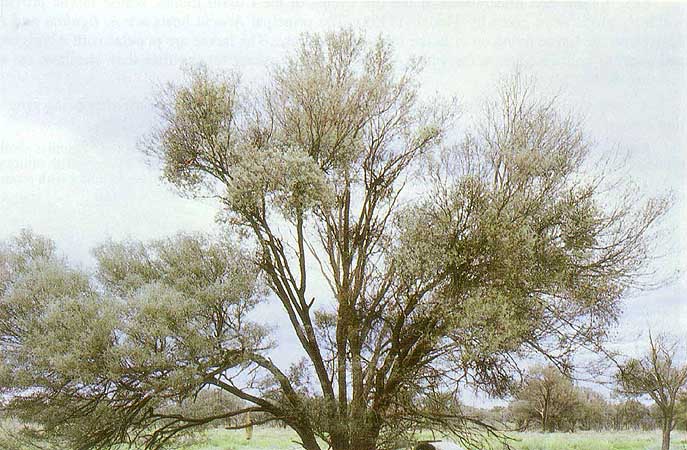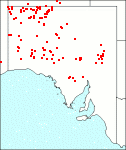Family: Fabaceae
Acacia kempeana

Citation:
F. Mueller, Chem. & Druggist, Australasian Suppl. 5(51):26 (1882).
Derivation: kempeana—commemorates A. H. Kempe (1844-1928), missionary, pastor of the Lutheran Church of Australia, one of the founders of the Hermannsburg Mission, N.T. 1877.
Synonymy: A. sibirica S. Moore, J. Linn. Soc.(Bot.)34:189 (1899); Racosperma kempeanum (F. Muell.)Pedley, Austrobaileya 2:350 (1987).
Common name: witchetty bush
Description:
Tall, glabrous, spreading, dull grey-green shrubs 2-4 m high with several stems from the base; branchlets angular, becoming terete, smooth; bark grey slightly furrowed.
Phyllodes oblong-lanceolate, 3-7 cm long, 4-12 mm broad, slightly curved, flat, coriaceous, glabrous, viscid when young, numerous fine parallel longitudinal veins sometimes 1-3 slightly more prominent than the rest, apex obtuse with a very short oblique point; glands basal.
Inflorescences simple, 1-2 per axil; spikes rather dense, mid-yellow, 1-2 cm long; peduncles glabrous, 5-12 mm long; flowers 5-merous.
Legumes oblong, 3-5 cm long, 10-15 mm broad, flat, firmly chartaceous, glabrous or glutinous, transversely veined, brown. Seeds transverse in legume; funicle with a few folds under a small aril.
|
|
Distribution:
|
North-Western, Lake Eyre (eastern part), Nullarbor, Gairdner-Torrens Flinders Ranges (northern part) and Eyre Peninsula (northern part) regions, in open woodland tall or low shrubland scattered amongst Acacia aneura and Triodia spp. Soils; neutral red earths, red siliceous sand and shallow calcareous loam. Rainfall 200 mm. Also W.Aust., N.T., Qld and N.S.W.
S.Aust.: NW, LE, NU, GT, FR, EP.
|
Flowering time: Irregular periods most of the year.
|

SA Distribution Map based
on current data relating to
specimens held in the
State Herbarium of South Australia
|
Biology:
No text
Related taxa:
Closely related to A. clivicola Pedley (1974), a Qld and N.T species with a similar shrubby habit, but differs mainly in its linear phyllodes, shorter flower spikes and narrower legumes with obliquely transverse seeds. A. tarculensis (sp. 102) has some affinities but differs in its glaucous phyllodes with prominent resinous margins.
Taxonomic notes:
Leaf and shoot growth of A. kempeana was studied by Maconochie (1973) in the Musgrave Ranges area. Peaks of foliage gain followed both summer and winter rains. Maximum losses occurred during the period of active growth and consisted of both mature and immature foliage.
Lange & Graham (1983) conducted experiments on the influence of rabbits on Acacta regeneration in the arid areas and A. kempeana was amongst the four species tested. Results showed that seedlings were severely pruned even with lowered post-myxomatosis rabbit population densities. Rabbit grazing pressure would significantly affect the recruitment in add zone Acacia populations.
Entry of water and subsequent germination of impermeable seeds of A. kempeana occurs after the strophiole lifts and cracks. The opening of a strophiole is induced by heat and is affected by the splitting of thin walled cells lying beneath the short palisade cells within the strophiole. The entry of water is facilitated by xylem vessels which almost touch the internal side of the seed coat and water could then reach the internal endosperm and embryo, Hanna (1984).
An analysis of oils of A. kempeana was presented in Bart et al. (1988) though the species was not further discussed in the text. The percentage of oil is very low, 0.01%, amongst the lowest of all the plants tested.
Three species of mistletoe have been collected on Acacia kempeana, almost equal low numbers of Amyema maidenii, pale-leaved mistletoe and Amyema preissii, wire-leaved mistletoe plus a single collection of Lysiana murrayi, mulga mistletoe.
Descriptions and illustrations of the life cycles of the Cossid moths, whose larvae provide witchetty grubs were given by Tindale (1953). The principal Acacia hosts are A. ligulata and A. kempeana, the larvae living on or in the roots of the shrubs. The larvae are popular with Aborigines and seem to hold fascination for white Australians who, except for the flies they swallow, eat so few insects.
A. kempeana seed is reported by Isaacs (1987) to be used by the Aborigines after being ground into a flour.
Cultivation:
Useful for planting in dry inland areas mainly as a low shelter belt or for soil stabilisation. Moderate growth rate.
Author:
Not yet available
Source:

|

